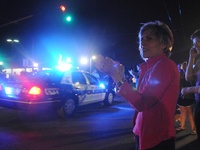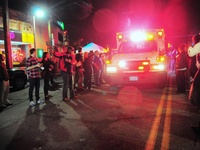After two bombings killed three and injured over 176 on April 15, police chased two suspects across Cambridge and Watertown starting around 10:30 p.m. Thursday night. After one suspect was shot during a shoot-out in Watertown in the early morning hours on Friday, police worked together with FBI, National Guard, and other units to find the second suspect. The search concentrated on Watertown, and investigators eventually closed in on the suspect in a Watertown backyard.
UPDATED: April 20, 2013, at 3:50 a.m.
A massive manhunt that began with the shooting of an MIT police officer in Cambridge Thursday night and paralyzed the greater Boston community for a full day concluded Friday evening with the apprehension of the second marathon bombing suspect in a standoff in Watertown.
Dzhokhar A. Tsarnaev, a 19-year-old Cambridge resident, was taken into custody Friday night after police found him hiding inside a dry-docked boat in the backyard of a Watertown house. Covered in blood and possibly wounded from two standoffs with law enforcement, Tsarnaev was taken to Beth Israel Deaconess Medical Center in “serious condition,” Boston Police Commissioner Edward F. Davis said.
Tsarnaev’s 26-year-old brother, Tamerlan Tsarnaev, was fatally shot in a firefight with police in Watertown early Friday morning. Along with his brother, he is suspected to have been a perpetrator of Monday’s bombings at the Boston Marathon, which killed three and injured more than 170. Dzhokhar Tsarnaev was a part of the Friday morning skirmish as well but evaded capture by the combined forces of municipal, state, and federal law enforcement for much of the day Friday.
With Tsarnaev at large until the FBI finally captured him at 8:45 p.m. Friday, Massachusetts Governor Deval L. Patrick ’78 ordered much of the greater Boston area to stay indoors and close businesses for the day. With the MBTA closed at the governor’s request and police forces forbidding all traffic into or out of Watertown, the combined police forces launched a door-to-door search of a 20-block section of Watertown, where the younger Tsarnaev was believed to be hiding. The Massachusetts State Police Bomb Squad was also deployed early Friday to search the area for any explosive devices, the Cambridge Police Department wrote in a statement early Friday.
After a day of futile searching, the governor lifted the city-wide lockdown shortly after 6 p.m., and for the first time all day, Watertown residents trickled outside of their homes and offices and into the streets.
Less than an hour after the ban was lifted and the chances of a quick capture seemed to have passed, a Watertown resident walked into his backyard and noticed blood on the cover of his boat, which was dry-docked there. Upon lifting the tarp from the top of the boat, the resident saw a man coated in blood sitting inside the boat, said Davis.
The Watertown resident returned inside and called law enforcement authorities, who rapidly mobilized and arrived at his house. According to Davis, the scene was located outside the perimeter of the door-to-door searches conducted earlier in the day.
Heavily armed forces, along with a heat-sensing State Police helicopter hovering overhead, surrounded the boat. The approach was cautious due to the risk that Tsarnaev, who was still shrouded by the boat’s tarp, had strapped deadly explosives to his body. After nearly an hour of gunfire and “flash bang” stun grenades used to disorient Tsarnaev, an FBI hostage rescue team closed in on the teenage suspect.
U.S. Attorney Carmen M. Ortiz said Tsarnaev was not read the customary Miranda Rights, which inform suspects of their civil liberties with respect to questioning and are normally required reading before interrogation. But when a suspect is deemed to pose an immediate threat to law enforcement officers or the general public, police can invoke the “public safety” exception—the only exception to the Miranda rule—and engage in interrogation of the suspect without reading the Miranda Rights.
News of Tsarnaev’s capture spread quickly over television and Twitter, offering Bostonians who had spent much of the week in fear a chance to breathe a sigh of relief and celebrate law enforcement’s victory over the alleged terrorists. In Watertown, just blocks from the final shootout, residents lined the streets and chanted, “USA! USA!” as emergency vehicles and state troopers exited the area. Residents from across the greater Boston area gathered on the Boston Common late Friday night, where just days before they had come together to mourn the victims of the marathon bombings.
At a press conference at 9:30 p.m. Friday, nearly 24 hours after the manhunt began, law enforcement officials from the FBI, the cities of Boston and Watertown, and the Massachusetts State Police stood beside politicians and public servants to celebrate the successful capture of the younger Tsarnaev.
“We are eternally grateful for the outcome here tonight. We have a suspect in custody,” Alben said. “We’re so grateful to bring justice and closure to this case.”
But officials stressed that the capture is just the beginning of the broader investigation into how and why the suspects were driven to terrorism. Ortiz said that her office will begin the difficult process of reconstructing the case and eventually prosecuting the surviving suspect.
Addressing the nation Friday night, President Barack Obama cautioned against jumping to conclusions or judgments about the case before all the details are worked out. Still, he said, Friday night’s capture and arrest marked the end of a sad chapter for Boston.
Recommended Articles
-
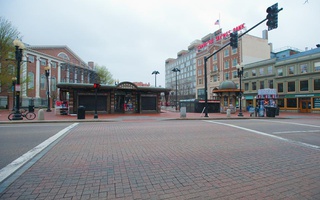 University Closes With Marathon Bombing Suspect Still At-Large
University Closes With Marathon Bombing Suspect Still At-Large -
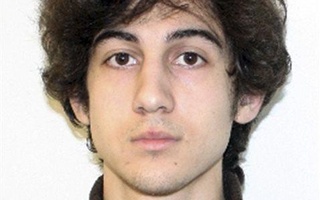 Months Before Marathon Bombing, Suspect Worked as Harvard Lifeguard
Months Before Marathon Bombing, Suspect Worked as Harvard Lifeguard -
Who, What, Where, and WarIf the U.S. has the opportunity to try terrorists in its own courts with successful results and without jeopardizing the safety of its citizens, it ought to. Making that choice would demonstrate our government’s faith in the efficacy and integrity of its judiciary.
-
 Reflections on the Boston Bombings and Manhunt
Reflections on the Boston Bombings and Manhunt -
Marathon Bombing Suspect Indicted on 30 CountsA 30-count federal indictment against Boston Marathon bombings suspect Dzhokhar A. Tsarnaev charged him with killing four people and using weapons of mass destruction, among other counts, officials said Thursday.
-
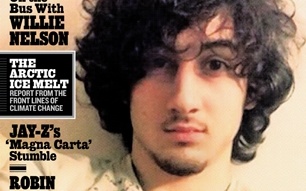 For Square Businesses, Rolling Stone Cover Presents Tricky Decision
For Square Businesses, Rolling Stone Cover Presents Tricky Decision









